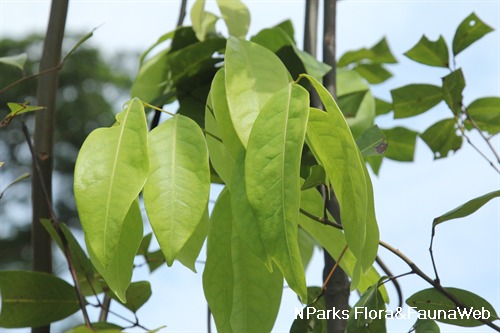_lowres.jpg)
Name
Classifications and Characteristics
| Plant Division | Angiosperms (Flowering Seed Plants) |
|---|---|
| Plant Growth Form | Tree (Small (6m-15m)), Shrub |
| Lifespan (in Singapore) | Perennial |
| Plant Shape | Irregular |
| Maximum Height | 10 m |
Biogeography
| Native Distribution | From India, south China, throughout Southeast Asia. |
|---|---|
| Native Habitat | Terrestrial (Primary Rainforest, Inland Cliff, Coastal Forest) |
| Preferred Climate Zone | Tropical |
| Local Conservation Status | Native to Singapore (Critically Endangered (CR)) |
Description and Ethnobotany
| Growth Form | It is a shrub or small tree, up to 10 m tall. |
|---|---|
| Foliage | Its alternate, stalked, pinnate leaves have 1–4 pairs of leaflets. Its stalked leaflets have papery leaf blades that are oval or egg-shaped and 5–40 by 1–15 cm. |
| Flowers | Its branched flowering shoot is hairy and 1.5–25 cm long. It bears short-stalked flowers, without petals or with up to 3 petals. |
| Fruit | Its stalked fruits are red, 7–20 mm long, and glabrous to sparsely hairy. They also have lobes that are egg-shaped to ellipsoid, and round to faintly 3-angled in cross section. Its seeds are round to ellipsoid and 7 mm long. |
| Habitat | It grows in primary and secondary forests up to 1,600 m altitude. It occurs locally in the vicinity of MacRitchie Reservoir, and Pulau Ubin. |
| Associated Fauna | Its flowers are insect-pollinated. |
| Cultivation | It can be propagated by seed. |
| Etymology | Greek mischos, stalk; Greek karpos, fruit, referring to the stalked fruit; Latin sundaicus, of the Sunda Islands, referring to one locality in the natural distribution of this species |
| Ethnobotanical Uses | Medicinal: A decoction of the root is used for cough. Timber & Products: Its wood is used as charcoal. |
Landscaping Features
| Landscaping | It is suitable for parks and gardens for its small stature and attractive fruits. |
|---|---|
| Desirable Plant Features | Ornamental Fruits |
| Landscape Uses | General, Parks & Gardens, Small Gardens, Coastal |
Fauna, Pollination and Dispersal
| Pollination Method(s) | Biotic (Fauna) |
|---|
Plant Care and Propagation
| Light Preference | Full Sun, Semi-Shade |
|---|---|
| Water Preference | Moderate Water |
| Plant Growth Rate | Moderate |
| Rootzone Tolerance | Moist Soils, Fertile Loamy Soils |
| Propagation Method | Seed |
Foliar
| Foliage Retention | Evergreen |
|---|---|
| Mature Foliage Colour(s) | Green |
| Mature Foliage Texture(s) | Leathery |
| Foliar Type | Compound |
| Foliar Arrangement Along Stem | Alternate |
| Foliar Attachment to Stem | Petiolate |
| Foliar Shape(s) | Non-Palm Foliage (Oval, Elliptical) |
| Foliar Venation | Pinnate / Net |
| Foliar Margin | Entire |
Floral (Angiosperm)
| Flower & Plant Sexuality | Bisexual Flowers |
| Flower Grouping | Cluster / Inflorescence |
|---|
Fruit, Seed and Spore
| Mature Fruit Colour(s) | Red |
|---|---|
| Mature Fruit Texture(s) | Smooth, Hairy / Hirsute |
| Fruit Classification | Simple Fruit |
| Fruit Type |
Image Repository
Others
| Master ID | 31326 |
|---|---|
| Species ID | 5723 |
| Flora Disclaimer | The information in this website has been compiled from reliable sources, such as reference works on medicinal plants. It is not a substitute for medical advice or treatment and NParks does not purport to provide any medical advice. Readers should always consult his/her physician before using or consuming a plant for medicinal purposes. |


_lowres.jpg)
_lowres.jpg)
_lowres.jpg)
_lowres.jpg)
_lowres.jpg)
_lowres.jpg)
_lowres.jpg)
_lowres.jpg)
_lowres.jpg)



